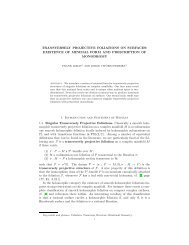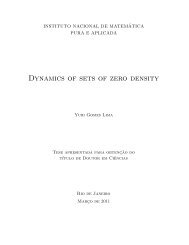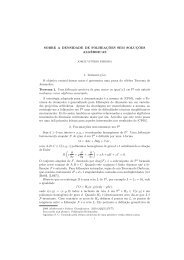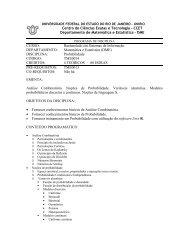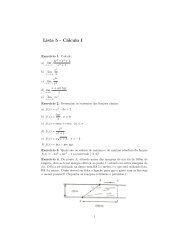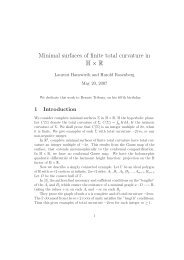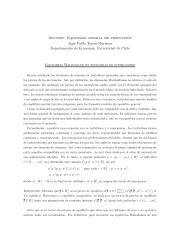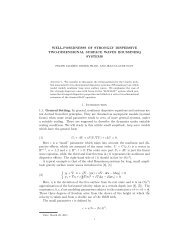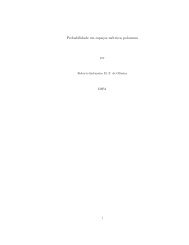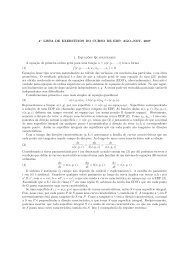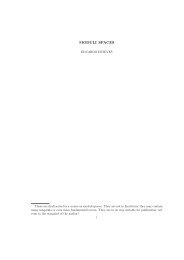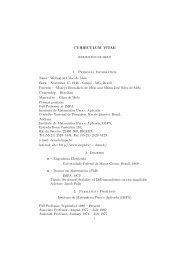ALGEBRAIC REDUCTION THEOREM FOR COMPLEX ...
ALGEBRAIC REDUCTION THEOREM FOR COMPLEX ...
ALGEBRAIC REDUCTION THEOREM FOR COMPLEX ...
Create successful ePaper yourself
Turn your PDF publications into a flip-book with our unique Google optimized e-Paper software.
<strong>ALGEBRAIC</strong> <strong>REDUCTION</strong> <strong>THEOREM</strong> <strong>FOR</strong> <strong>COMPLEX</strong><br />
CODIMENSION ONE SINGULAR FOLIATIONS<br />
DOMINIQUE CERVEAU 1 , ALCIDES LINS-NETO 2 , FRANK LORAY 1 ,<br />
JORGE VITORIO PEREIRA 1,2 AND FRÉDÉRIC TOUZET1<br />
Abstract. Let M be a compact complex manifold equipped with<br />
n = dim(M) meromorphic vector fields that are independant at a<br />
generic point. The main theorem is the following. If M is not<br />
bimeromorphic to an algebraic manifold, then any codimension<br />
one complex foliation F with a codimension ≥ 2 singular set is the<br />
meromorphic pull-back of an algebraic foliation on a lower dimensional<br />
algebraic manifold, or F is transversely projective outside a<br />
proper analytic subset. The two ingredients of the proof are the<br />
Algebraic Reduction Theorem for the complex manifold M and an<br />
algebraic version of Lie’s first Theorem which is due to J. Tits.<br />
1. Introduction<br />
Let M be a compact connected complex manifold of dimension n ≥<br />
2. A (codimension 1 singular holomorphic) foliation F on M will be<br />
given by a covering of M by open subsets (U j ) j∈J and a collection<br />
of integrable holomorphic 1-forms ω j on U j , ω j ∧ dω j = 0, having<br />
codimension ≥ 2 zero-set such that, on each non empty intersection<br />
U j ∩ U k , we have<br />
(∗) ω j = g jk · ω k , with g jk ∈ O ∗ (U j ∩ U k ).<br />
Let Sing(ω j ) = {p ∈ U j ; ω j (p) = 0}. Condition (∗) implies that<br />
Sing(F) := ∪ j∈J Sing(ω j ) is a codimension ≥ 2 analytic subset of M. If<br />
ω is an integrable meromorphic 1-form on M, ω ∧ dω = 0, then we can<br />
associate to ω a foliation F ω as above. Indeed, at the neighborhood of<br />
any point p ∈ M, one can write ω = f · ˜ω with f meromorphic, sharing<br />
the same divisor with ω; therefore, ˜ω is holomorphic with codimension<br />
≥ 2 zero-set and defines F ω on the neighborhood of p.<br />
Date: March 2005.<br />
1 IRMAR, Campus de Beaulieu, 35042 Rennes Cedex, France<br />
2 IMPA, Estrada Dona Castorina, 110, Horto, Rio de Janeiro, Brasil.<br />
1
2 CERVEAU, LINS-NETO, LORAY, PEREIRA AND TOUZET<br />
The manifold M is called pseudo-parallelizable, if there exist n meromorphic<br />
vector fields X 1 , . . . , X n on M that are independent at a<br />
generic point. On such a manifold, differential calculus can be done<br />
likely as on an algebraic manifold and a foliation F is always defined<br />
by a global meromorphic 1-form ω (satisfying ω ∧ dω = 0). Indeed,<br />
given a meromorphic vector field on M which is not identically tangent<br />
to F, then there exists a unique meromorphic 1-form ω defining F and<br />
satisfying ω(X) ≡ 1. We will denote F = F ω .<br />
The notion of pseudo-parallelizable manifolds is invariant by bimeromorphic<br />
transformations; more generally, if f : ˜M M is meromorphic<br />
and generically étale, and if M is pseudo-parallelizable, then ˜M is<br />
also. Besides algebraic manifolds, one can find complex tori, Hopf manifolds,<br />
Iwasawa threefolds and homogeneous spaces among examples<br />
of such manifolds. Also, manifolds constructed in [6, 7] are pseudoparallelizable<br />
but not of the previous type. Of course, even among<br />
surfaces, there are manifolds which are not pseudo-parallelizable.<br />
We say that F ω is transversely projective if there exist meromorphic<br />
1-forms ω 0 = ω, ω 1 and ω 2 on M satisfying<br />
(1)<br />
⎧<br />
⎨dω 0 = ω 0 ∧ ω 1<br />
dω 1 = ω 0 ∧ ω 2<br />
⎩<br />
dω 2 = ω 1 ∧ ω 2<br />
This means that, outside the polar and singular set of the ω i ’s, the<br />
foliation F is (regular and) transversely projective in the classical sense<br />
(see [3]) and this projective structure has “reasonable singularities”.<br />
See [8, 10] for basic properties and examples of transversely projective<br />
foliations in the meromorphic singular sense above. When ω 2 = 0<br />
(i.e. dω 1 = 0) or ω 1 = 0 (i.e. dω 0 = 0), we respectively say that F ω<br />
is actually transversely affine or euclidian. For instance, the foliation<br />
defined on CP(2) by the closed 1-form ω 0 = dx + dy is transversely<br />
y<br />
euclidian in the main affine chart (x, y) ∈ C 2 with poles along the line<br />
at infinity; the other euclidian structure given on C 2 by ˜ω 0 = e x dx +<br />
dy does not extend meromorphically on CP(2). One can find in [10]<br />
examples of germs of foliations admitting a unique projective structure<br />
outside an analytic set, but that cannot extend meromorphically along<br />
this set. We do not know if such phenomena can happen for foliations<br />
on compact manifold.
FOLIATED <strong>ALGEBRAIC</strong> <strong>REDUCTION</strong> 3<br />
Now, denote by a(M) the algebraic dimension of M, that is the transcendence<br />
degree over C of the field M(M) of meromorphic functions<br />
on M. The algebraic Reduction Theorem (see [11] or section 2) provides<br />
a meromorphic map f : M N onto a projective manifold N<br />
of dimension a(M) such that M(M) identifies with f ∗ M(N). In fact,<br />
the fibers of f are the maximal subvarieties on which every meromorphic<br />
function on M is constant. Of course, the map f is unique up to<br />
birational modifications of N. We will denote by red : M red(M)<br />
this map. There exist pseudo-parallelizable manifolds M of arbitrary<br />
dimension n ≥ 2 with arbitrary algebraic dimension 0 ≤ a(M) ≤ n.<br />
When M is not algebraic (up to a bimeromorphism), i.e. a(M) < n,<br />
our main result is the following “Foliated Reduction Theorem”.<br />
Theorem 1.1. Let F be a complex codimension one singular foliation<br />
on a pseudo-parallelizable compact complex manifold M. Then<br />
• F is the pull-back by the reduction map M red(M) of an<br />
algebraic codimension one foliation F defined on red(M),<br />
• or F is transversely projective.<br />
More precisely, we are in the former case when the fibers of the map<br />
M red(M) are contained in the leaves of F. In the case a(M) = 0<br />
(i.e. M(M) = C) or a(M) = 1, we have no alternative (if F is the<br />
pull-back of a foliation by points on a curve, then it is automatically<br />
transversely euclidean)<br />
Corollary 1.2. Let F and M be as above and assume a(M) = 0 or 1.<br />
Then F is transversely projective.<br />
When M is simply connected and a(M) = 0, it follows that F necessarily<br />
admits an invariant hypersurface, that is the singular set of<br />
the projective structure. Indeed, if the projective structure were not<br />
singular, the development map of the structure would provide a non<br />
constant meromorphic function on M, thus contradicting a(M) = 0.<br />
In fact, our proof gives a more precise statement in the case the fibres<br />
of the map M red(M) have dimension 1 or 2<br />
Theorem 1.3. Let F be a complex codimension one singular foliation<br />
on a pseudo-parallelizable compact complex manifold M and assume<br />
that a(M) = n − 1 or n − 2. Then<br />
• F is the pull-back by the reduction map M red(M) of an<br />
algebraic codimension one foliation F defined on red(M),<br />
• or F is transversely affine.
4 CERVEAU, LINS-NETO, LORAY, PEREIRA AND TOUZET<br />
In the case M is a surface, we deduce<br />
Corollary 1.4. Let F be a singular foliation on a non algebraic pseudoparallelizable<br />
compact surface S. Then F is transversely affine.<br />
Here, we use Chow-Kodaira Theorem ([11], p.249) that a surface<br />
having algebraic dimension 2 is actually projective.<br />
In the case of a threefold, we resume<br />
Corollary 1.5. Let M be a 3-dimensional pseudo-parallelizable complex<br />
manifold and let F be a foliation of M. We have the following<br />
possibilities:<br />
(1) a(M) = 3 and F is bimeromorphically equivalent to an algebraic<br />
foliation of an algebraic manifold;<br />
(2) a(M) = 2 and F is the meromorphic pull-back of a foliation on<br />
an algebraic surface, or F is transversely affine;<br />
(3) a(M) = 1 and F is transversely affine;<br />
(4) a(M) = 0 and F is transversely projective.<br />
We now give example illustrating that the affine cases (2) and (3)<br />
and the projective case (4) do occur in the statement above.<br />
Example 1.6. A complex torus T n = C n /Λ, Λ a co-compact lattice,<br />
can have arbitrary algebraic dimension 0 ≤ a ≤ n and carries the n<br />
independant 1-forms dz 1 , . . . , dz n . The quotient by the involution σ :<br />
z ↦→ −z, z = (z 1 , . . . , z n ) is a variety with conic singularities that can<br />
be desingularized after one blowing-up. The resulting smooth manifold<br />
M is pseudo-parallelizable as soon as a > 0, with algebraic dimension a.<br />
Indeed, the algebraic reduction of T n is an algebraic torus T a (see [2])<br />
on which the involution σ is well defined; after chosing a meromorphic<br />
function f ∈ M(T a ) = M(T n ) satisfying f ◦σ = −f, the meromorphic<br />
1-forms f · dz i , i = 1, . . . , n, are σ invariant and provide a pseudoparallelism<br />
on the quotient manifold M. The linear foliation F defined<br />
by a generic linear combination of the 1-forms f · dz i is transversely<br />
euclidean on T n and transversely affine (and not better) on M.<br />
Example 1.7. Consider the quotient M := ΓSL(2, C) by a cocompact<br />
lattice Γ ⊂ SL(2, C). The left-invariant 1-forms define a<br />
parallelism on M. Following [5], there is no non constant meromorphic<br />
function on M (i.e. the algebraic dimension of M is a(M) = 0).<br />
Now, it is classical that the foliation F defined by a left-invariant 1-<br />
form (some of them are integrable) is transversely projective and not<br />
better since its monodromy is given by Γ.
FOLIATED <strong>ALGEBRAIC</strong> <strong>REDUCTION</strong> 5<br />
One of the ingredients for the proof of Theorem 1.1 is the following<br />
algebraic version, due to J. Tits [9], of Lie’s first Theorem<br />
Lemma 1.8. Let L be a finite dimensional Lie algebra over a field<br />
K of characteristic 0. If L has a codimension one Lie subalgebra L ′ ,<br />
then there exists a non trivial morphism φ : L → sl(2, K) such that the<br />
kernel of φ is contained in L ′ .<br />
We end the paper by proving the following proposition generalizing<br />
some of the results obtained by É. Ghys in [4] for the foliations on<br />
complex tori.<br />
Proposition 1.9. Let F be a foliation on a compact manifold M and<br />
assume that there exist n = dim(M) independent closed meromorphic<br />
1-forms on M. Then we have the following alternative:<br />
• F is the pull-back of a foliation F on red(M) via the algebraic<br />
reduction map M red(M),<br />
• or F is transversely euclidean, i.e. defined by a closed meromorphic<br />
1-form.<br />
We would like to thank Étienne Ghys who helped us to improve<br />
the preliminary version [1] of our results. He brought reference [9]<br />
to our knowledge and provided an argument to avoid Godbillon-Vey<br />
sequences in order to conclude the proof of our Reduction Theorem.<br />
In particular, Theorem 1.3 was proved in [1] only for three-folds in the<br />
case a(M) = n − 2.<br />
A natural question raised by the present work is: can we avoid with<br />
“pseudo-parallelizable” assumption in our Reduction Theorem In<br />
fact, even in the algebraic case, all known singular foliations on CP n ,<br />
n ≥ 3, are transversely projective, or pull-back by a rational map<br />
CP n CP 2 of a foliation on the plane. Is there a general principle<br />
In a forthcoming paper, we further investigate these questions<br />
using Godbillon-Vey sequences. Among other results, we prove that<br />
our Reduction Theorem still holds whenever there exists at least one<br />
meromorphic vector field generically transversal to F on M.
6 CERVEAU, LINS-NETO, LORAY, PEREIRA AND TOUZET<br />
2. Algebraic Reduction Theorem [11]<br />
We now state the Algebraic Reduction Theorem. Let M be a compact<br />
connected complex manifold and consider the field M(M) of meromorphic<br />
functions on M. The algebraic dimension<br />
a(M) ∈ {0, 1, . . . , dim(M)}<br />
of M is the transcendence degree of M(M) over C, i.e. the maximal<br />
number of elements f 1 , . . . , f a ∈ M(M) satisfying<br />
df 1 ∧ · · · ∧ df a ≠ 0.<br />
Recall that a(M) = dim(M) if, and only if, M is bimeromorphically<br />
equivalent to an algebraic manifold. If not, we have (see [11])<br />
Theorem 2.1 (Algebraic Reduction). Let M be a compact connected<br />
complex manifold of algebraic dimension n = a(M). There exist<br />
(1) a bimeromorphic modification Ψ : ˜M → M,<br />
(2) an holomorphic projection π : ˜M → N with connected fibers<br />
onto an n-dimensional algebraic manifold N<br />
such that Ψ ∗ M(M) = π ∗ M(N).<br />
We will denote by red the meromorphic map π ◦Ψ −1 . When a(M) <<br />
dim(M), i.e. M is not bimeromorphic to an algebraic manifold ˜M, M<br />
is naturally equipped with the canonical codimension a(M) fibration<br />
G induced by fibers of red.<br />
The space X (M) of meromorphic vector fields over M acts by derivation<br />
on M(M) and, in this sense, preserves the fibration G. Precisely,<br />
given any X ∈ X (M), the local flow of X sends fibers to fibers at the<br />
neighborhood of any point p ∈ M where X and G are regular. In other<br />
words, any vector field X on M is a lifting of some vector field Y on<br />
the reduction N = red(M). This can be seen also directly from the<br />
fact that a derivation on M(M) := red ∗ M(N) is actually a derivation<br />
on M(N). The kernel X 0 (M) = {X ∈ X (M)|X(f) = 0, ∀f ∈ M(M)}<br />
coincides with the subspace of those vector fields that are tangent<br />
to the fibration G. The space X (M) is a Lie algebra over C, having<br />
infinite dimension as soon as a(M) ≠ 0, and X 0 (M) is an ideal:<br />
[X 0 (M), X (M)] ⊂ X 0 (M). Observe that X 0 (M) is also a Lie algebra<br />
over the field M(M), having dimension ≤ dim(M) − a(M). We take<br />
care that the space of meromorphic vector fields X (F ) on a given fiber<br />
F can actually be much bigger than the restriction X 0 (M)| F : except in<br />
the case a(M) = 0, some of the fibers could carry non constant meromorphic<br />
functions (even, all fibers could be algebraic, like in Iwasawa<br />
three-fold).
FOLIATED <strong>ALGEBRAIC</strong> <strong>REDUCTION</strong> 7<br />
Given a foliation F on M, we will distinguish between the case where<br />
F is tangent to the fibration G and the case where they are transversal<br />
at a generic point. The latter case will be studied in Section 3. The<br />
former case is completely understood by means of<br />
Lemma 2.2. Let F be a foliation on a complex manifold M. Let<br />
π : M → N be a surjective holomorphic map whose fibers are connected<br />
and tangent to F, that is, contained in the leaves of F. Then, F is the<br />
pull-back by π of a foliation ˜F on N.<br />
Proof. In a small connected neighborhood U ⊂ M of a generic point<br />
p ∈ M, the foliation F is regular, defined by a local submersion f :<br />
U → C. Since f is contant along the fibers of π in U, we can factorize<br />
f = ˜f ◦ π for an holomorphic function ˜f : π(U) → C. In particular,<br />
the function ˜f defines a codimension one singular foliation ˜F on the<br />
open set π(U). Of course, ˜F does not depend on the choice of f.<br />
Moreover, since f = ˜f ◦ π, the function f extends to the whole tube<br />
T := π −1 (π(U)). By connectivity of U and the fibers of π, the tube<br />
T is connected and the foliation F is actually defined by f on the<br />
whole of T , coinciding with π ∗ ( ˜F) on T . In this way, we can define a<br />
foliation ˜F on N \ S, where S = {p ∈ N ; π −1 (p) ⊂ Sing(F)} such<br />
that F = π ∗ ( ˜F). We note that S has codimension ≥ 2 in N; therefore,<br />
˜F extends on N by Levi’s Extension Theorem.<br />
□<br />
Corollary 2.3. Let F be a foliation on a compact manifold M. If the<br />
fibers of the algebraic reduction red : M red(M) are tangent to F,<br />
then F is actually the pull-back of an algebraic foliation ˜F on red(M).<br />
In particular, even if M was not pseudo-parallelizable, F is a posteriori<br />
defined by a global meromorphic 1-form, namely the pull-back of<br />
any rational 1-form defining ˜F on the algebraic manifold red(M).
8 CERVEAU, LINS-NETO, LORAY, PEREIRA AND TOUZET<br />
3. Proof of the main result<br />
3.1. Foliated Algebraic Reduction: the case a(M) = 0. Recall<br />
first the classical<br />
Lemma 3.1 (Lie). Let L be a (finite dimensional) transitive Lie algebra<br />
of holomorphic vector fields defined on some neighborhood of 0 ∈ C.<br />
Then, after a change of local coordinate, we are in one of the following<br />
three cases:<br />
(1) L = C · ∂ z ;<br />
(2) L = C · ∂ z + C · z∂ z ;<br />
(3) L = C · ∂ z + C · z∂ z + C · z 2 ∂ z .<br />
In particular, L is a representation of a subalgebra of sl(2, C).<br />
We need a technical Lemma. Given a vector field X on a manifold<br />
M, we denote by L X the Lie derivative on differential k-forms. Notice<br />
that, when X is a meromorphic vector field on a compact manifold M,<br />
then L X is trivial on the 0-forms M(M)<br />
L X f = 0,<br />
∀f ∈ M(M)<br />
if, and only if, the vector field X is actually tangent to the fibers of the<br />
algebraic reduction red : M → red(M) (see Theorem 2.1).<br />
Lemma 3.2. Let M be a compact manifold, ω be a meromorphic 1-<br />
form on M and X be a meromorphic vector field satisfying ω(X) = 1<br />
and L X M(M) = 0. Then, for all meromorphic vector field Y on M,<br />
we have<br />
L (i)<br />
X ω(Y ) = (−1)i ω(L i XY )<br />
where L X Y = [X, Y ].<br />
Proof. Since ω(X) = 1, we have<br />
L X ω = d(ω(X)) + dω(X, .) = dω(X, .) .<br />
Therefore, for any vector field Y , we have<br />
L X ω(Y ) = dω(X, Y ) = L X (ω(Y )) − L Y (ω(X)) − ω([X, Y ]) .<br />
By assumption, we have that L X (ω(Y )) = L X (function) = 0 and<br />
L Y (ω(X)) = L Y (constant) = 0. Thus we conclude that<br />
L X ω(Y ) = −ω([X, Y ]) .<br />
The proof immediately follows by induction on i.<br />
□
FOLIATED <strong>ALGEBRAIC</strong> <strong>REDUCTION</strong> 9<br />
Lemma 3.3. Let F be the foliation defined by a meromorphic 1-form<br />
ω on a manifold M and X be a meromorphic vector field satisfying<br />
ω(X) = 1 and L (3)<br />
X ω = 0. Then, the meromorphic triple (ω, L Xω, L (2)<br />
X ω)<br />
satisfies (1): the foliation F defined by ω 0 = ω is transversely projective.<br />
Of course, when L (2)<br />
X<br />
ω = 0 (respectively L(1)<br />
X<br />
ω = 0) the foliation F<br />
is actually transversely affine (resp. euclidean).<br />
Proof. First of all, the integrability condition of ω is equivalent to<br />
(2) ω ∧ dω = 0 ⇔ dω = ω ∧ L X ω.<br />
Indeed, from L X ω = d(ω(X)) + dω(X, .) = dω(X, .), we derive<br />
0 = ω ∧ dω(X, ., .) = ω(X) · dω − ω ∧ (dω(X, .)) = dω − ω ∧ L X ω<br />
(the converse is obvious). We thus obtain the first condition<br />
dω 0 = ω 0 ∧ ω 1 .<br />
Now, applying Lie derivative to this equality yields<br />
d(L X ω 0 ) = L X (dω 0 ) = L X ω 0 ∧ ω 1 + ω 0 ∧ L X ω 1 ,<br />
i.e. dω 1 = ω 0 ∧ ω 2 since ω 1 ∧ ω 1 = 0. Applying a last time the Lie<br />
derivative, we finally get<br />
dω 2 = ω 1 ∧ ω 2 + ω 0 ∧ ω 3<br />
by assumption, ω 3 = L (3)<br />
X<br />
ω = 0 and we get the projective relations<br />
(1). □<br />
Let M be a pseudo-parallelizable compact manifold with no non<br />
constant meromorphic function. Therefore, the Lie algebra L of meromorphic<br />
vector fields on M has dimension n = dim(M). If F is a<br />
foliation on M, then the Lie algebra L ′ of those vector fields tangent<br />
to F has dimension n − 1. Following Lemma 1.8, there exists a morphism<br />
φ : L → sl(2, C) such that ker(φ) ⊂ L ′ ⊂ L. Discussing on<br />
the codimension of ker(φ), we construct a meromorphic vector field X<br />
satisfying ω(X) = 1 (in particular X ∈ L \ L ′ ) such that L (3)<br />
X ω = 0.
10 CERVEAU, LINS-NETO, LORAY, PEREIRA AND TOUZET<br />
3.1.1. First Case: ker(φ) has codimension 1. Therefore, L ′ = ker(φ).<br />
In particular, L ′ is an ideal of L: [L, L ′ ] ⊂ L ′ . Let X be any meromorphic<br />
vector field satisfying ω(X) = 1. For every Y ∈ L, we can<br />
write<br />
where c ∈ C and Y ′ ∈ L ′ . Thus<br />
Y = c · X + Y ′ ,<br />
ω([X, Y ]) = ω([X, Y ′ ]) = 0 ∀Y ∈ L,<br />
allowing us to conclude that L X ω = 0 (see Lemma 3.2). Finally, ω 0 = ω<br />
is closed.<br />
3.1.2. Second Case: codim ker(φ) = 2. One can choose a basis X 1 , X 2<br />
of L/ ker(φ) such that ω(X 1 ) = 1, X 2 is a basis for L ′ / ker(φ) and<br />
either [X 1 , X 2 ] = X 1 , or [X 1 , X 2 ] = −X 2 .<br />
Indeed, after composing φ by an automorphism of sl(2, C), the dimension<br />
two subalgebra φ(L) identifies with the Lie algebra generated by<br />
( )<br />
( )<br />
−1 0<br />
0 1<br />
A =<br />
and B =<br />
0 1<br />
0 0<br />
and φ(L ′ ) is the one dimensional subalgebra generated by A or B.<br />
Then, just choose X 1 and X 2 so that correspondingly (φ(X 1 ), φ(X 2 )) =<br />
(B, A) or (A, B) and normalize ω 0 :=<br />
ω so that ω ω(X 1 ) 0(X 1 ) = 1. Therefore,<br />
ω 0 (L i X 1<br />
X 2 ) = 0 (i.e. L i X 1<br />
X 2 ∈ L ′ ) for i = 1 or 2. Finally, after<br />
writing every vector field Y ∈ L into the form<br />
Y = c 1 · X 1 + c 2 · X 2 + Y ′ ,<br />
with c 1 , c 2 ∈ C and Y ′ ∈ ker(φ) and applying Lemma 3.2 as in Section<br />
3.1.1, we conclude that F is transversely affine.<br />
3.1.3. Third Case: codim ker(φ) = 3. We construct a basis X 1 , X 2 , X 3<br />
of L/ ker(φ) such that ω(X 1 ) = 1, X 2 , X 3 is a basis for L ′ / ker(φ) and,<br />
after composing φ by an automorphism of sl(2, C),<br />
( )<br />
( )<br />
( )<br />
0 0<br />
−1 0<br />
0 1<br />
φ(X 1 ) = , φ(X<br />
1 0<br />
2 ) =<br />
and φ(X<br />
0 1<br />
3 ) = .<br />
0 0<br />
Therefore, we have<br />
[X 1 , [X 1 , [X 1 , X 3 ]]] = [X 1 , [X 1 , X 2 ]] = 0 mod ker(φ)<br />
and ω(L 3 X 1<br />
(Y )) = 0 for all Y ∈ L. Finally, F is transversely projective.
FOLIATED <strong>ALGEBRAIC</strong> <strong>REDUCTION</strong> 11<br />
3.2. Codimension one Lie subalgebras over K. Before proving<br />
Theorem 1.1 for arbitrary algebraic dimension a(M), we need the following<br />
more complete statement for Lemma 1.8.<br />
Lemma 3.4 (Tits [9]). Let L be a finite dimensional Lie algebra over<br />
a field K, char(K) = 0, having a codimension one Lie subalgebra L ′ :<br />
[L ′ , L ′ ] ⊂ L ′ . Then L also has a codimension ≤ 3 Lie-ideal I, [L, I] ⊂<br />
I, which is contained in L ′ and we are in one of the following 3 cases:<br />
(1) L/I = K · X and L ′ = I;<br />
(2) L/I = K · X + K · Y with [X, Y ] = X and L ′ /I = K · Y ;<br />
(3) L/I = K · X + K · Y + K · Z with [X, Y ] = X, [X, Z] = 2Y and<br />
[Y, Z] = Z and L ′ /I = K · Y + K · Z.<br />
In other words, there exists a non trivial morphism φ : L → sl(2, K)<br />
whose kernel ker(φ) = I is contained in L ′ .<br />
Applying this Lemma to a finite dimensional transitive subalgebra<br />
L ⊂ X (C, 0) and to the subalgebra L ′ of those vector fields fixing 0,<br />
we retrieve a part of Lie’s Lemma 3.1. In this sense, Lemma 3.4 may<br />
be considered as an algebraic version of Lie’s Lemma.<br />
3.3. Foliated Algebraic Reduction: the general case. Let M be<br />
a pseudo-parallelizable compact manifold having algebraic dimension<br />
a(M) < dim M and let F be a foliation on M. We assume that F is<br />
generically transverse to the fibers given by the Algebraic Reduction<br />
Theorem, otherwise we conclude with Lemma 2.2 that we are actually<br />
in the second alternative of Theorem 1.1. The idea of the proof is<br />
to proceed as in section 3.1 along the fibers, but dealing only with<br />
objects (vector fields and functions) living on the ambient manifold<br />
M. Denote by X 0 (M) the space of meromorphic vector fields that are<br />
tangent to the fibers. Recall that L := X 0 (M) is a Lie algebra of<br />
dimension dim(M) − a(M) over the field K := M(M) of meromorphic<br />
functions on M. Consider L ′ ⊂ L the Lie subalgebra of those vector<br />
fields that are tangent to the foliation F. Clearly, L ′ has codimension<br />
1 in L. Applying Lemma 3.4 to this situation, we see that there is an<br />
ideal I ⊂ L contained in L ′ , and there is some X ∈ L \ L ′ satisfying<br />
L 3 X V ∈ I for any V ∈ X 0(M) (for instance, L 3 X X = L3 X Y = L3 X Z = 0<br />
modulo I in case (3) of Lemma 3.4). Let ω be the unique meromorphic<br />
1-form defining the foliation F and satisfying ω(X) = 1. Since I ⊂ L ′ ,<br />
we deduce that ω(L 3 X V ) = 0 for any V ∈ X 0(M).
12 CERVEAU, LINS-NETO, LORAY, PEREIRA AND TOUZET<br />
Now, in order to conclude by means of Lemma 3.2, we have to<br />
prove that ω(L 3 XV ) = 0 for any V ∈ X (M). It is enough to consider<br />
V ∈ X ′ (M), the subspace of meromorphic vector fields tangent to the<br />
foliation, since X together with X ′ (M) span X (M) over M(M). We<br />
now consider the three cases given by Lemma 3.4. We recall that, in<br />
any case, [X, L] ∈ L and [V, L ′ ] ∈ L ′ (Frobenius integrability condition<br />
for F).<br />
3.3.1. First Case: L ′ is an ideal of L. We have [X, V ] = f · X modulo<br />
I = L ′ for some f ∈ M(M). Therefore, [X, [X, V ]] = 0 and ω(L 2 X V ) =<br />
0 by Lemma 3.2. We conclude by Lemma 3.3 that the foliation F is<br />
transversely affine.<br />
3.3.2. Second Case: L ′ /I is generated by Y with [X, Y ] = X modulo<br />
I. We have [X, V ] = f · X + g · Y mod I and [Y, V ] = h · Y mod I for<br />
coefficients f, g, h ∈ M(M) (here, we use the fact that both Y and V<br />
are tangent to F, whence their Lie bracket). Applying Jacobi identity<br />
to X, Y and Z yields:<br />
[X, [Y, V ]] + [V, [X, Y ]] + [Y, [V, X]] = h · X − g · Y = 0<br />
and we have h = g = 0. In particular, [X, V ] = f · X and [X, [X, V ]] =<br />
0. We conclude as before that F is transversely affine.<br />
3.3.3. Third Case: L ′ /I is generated by Y, Z with [X, Y ] = X, [X, Z] =<br />
2Y and [Y, Z] = Z modulo I. We have:<br />
⎧<br />
⎨[X, V ] = f · X + g · Y + h · Z<br />
[Y, V ] = i · Y + j · Z mod I<br />
⎩<br />
[Z, V ] = k · Y + l · Z<br />
for some coefficients f, g, h, i, j, k, l ∈ M(M). Jacobi identities yield:<br />
[X, [Y, V ]] + [V, [X, Y ]] + [Y, [V, X]] =<br />
[X, [Z, V ]] + [V, [X, Z]] + [Z, [V, X]] =<br />
= i · X + (2j − g) · Y − 2h · Z = 0<br />
= k · X + 2(f + l − i) · Y + (g − 2j) · Z = 0<br />
[Y, [Z, V ]] + [V, [Y, Z]] + [Z, [V, Y ]] = −k · Y + i · Z = 0<br />
modulo I and thus h = i = k = 0, l = −f and g = 2j. In particular,<br />
[X, [X, [X, V ]]] = 0 and F is transversely projective, thus proving the<br />
Theorem 1.1. Theorem 1.3 corresponds to the first 2 cases above and<br />
immediately follows.
FOLIATED <strong>ALGEBRAIC</strong> <strong>REDUCTION</strong> 13<br />
3.4. Proof of Proposition 1.9. If the algebraic dimension a(M) of M<br />
is n, the second alternative is trivially satisfied. Also, when a(M) = 0,<br />
any 1-form on M is closed since it is a linear combination of the given<br />
n closed ones with coefficients in M(M) = C; in particular, any 1-form<br />
defining F is closed.<br />
Let f 1 , . . . , f q ∈ M(M), q = a(M), be such that df 1 ∧ . . . ∧ df q ≠ 0.<br />
By our hypothesis we can find p = n − q closed meromorphic 1-forms<br />
such that ω 1 ∧ . . . ∧ ω p ∧ df 1 ∧ . . . ∧ df q ≠ 0. If ω is a 1-form defining F<br />
then we can write it as<br />
ω = ∑ λ i ω i + ∑ µ j df j ,<br />
where the λ i and the µ j belong to M(M). If all the λ i are zero then<br />
we are in the first case; if not we can suppose that λ 1 = 1.<br />
Therefore<br />
dω =<br />
p∑<br />
dλ i ∧ ω i + ∑ j<br />
i=2<br />
dµ j ∧ df j ,<br />
and the integrability condition writes:<br />
0 = ω 1 ∧<br />
( ∑<br />
i≤2<br />
dλ i ∧ ω i + ∑ j<br />
dµ j ∧ df j<br />
)<br />
+<br />
( ∑<br />
i≤2<br />
λ i ω i + ∑ j<br />
µ j df j<br />
)<br />
∧<br />
dλ i ∧ ω i + ∑ j<br />
dµ j ∧ df j<br />
)<br />
.<br />
( ∑<br />
i≤2<br />
First suppose that dim(M) ≥ 3. Notice that the dλ i and dµ j are in<br />
the M(M)-vector space generated by the df i . Since the meromorphic<br />
3-forms ω i ∧ω j ∧df k together with ω i ∧df j ∧df k are linearly independant<br />
over M(M), we deduce that the first term is zero: ω 1 does not occur<br />
when one developp the second term on the 3-forms above. Therefore<br />
q∑<br />
dλ i ∧ ω i + ∑ j<br />
i=2<br />
dµ j ∧ df j = 0 ,<br />
and consequently ω is closed.<br />
When dim M = 2, we just have to consider the case where a(M) = 1.<br />
Then, ω = ω 1 + λ 1 df 1 and dω = dλ 1 ∧ df 1 = 0 since a(M) = 1.
14 CERVEAU, LINS-NETO, LORAY, PEREIRA AND TOUZET<br />
References<br />
[1] D. Cerveau, A. Lins Neto, F. Loray, J.V. Pereira and F. Touzet, Algebraic<br />
Reduction Theorem for complex codimension one singular foliations.<br />
arXiv:math.CA/0406293 (2004).<br />
[2] O. Debarre, Tores et variétés abéliennes complexes, Cours Spécialisés, 6. Société<br />
Mathématique de France, Paris; EDP Sciences, Les Ulis, 1999.<br />
[3] C. Godbillon, Feuilletages. Études géométriques. With a preface by G. Reeb.<br />
Progress in Mathematics, 98. Birkhuser Verlag, Basel, 1991.<br />
[4] É. Ghys, Feuilletages holomorphes de codimension un sur les espaces homogènes<br />
complexes, Ann. Fac. Sci. Toulouse Math. (6) 5 (1996), no. 3, 493–519.<br />
[5] A. T. Huckleberry, G. A. Margulis, Invariant analytic hypersurfaces, Invent.<br />
Math. 71 (1983), no. 1, 235–240.<br />
[6] S. López de Medrano, A. Verjovsky, A new family of complex, compact, non<br />
symplectic manifolds, Bol. Soc. Mat. Bra. 28, 2 (1997), 253–269.<br />
[7] L. Meersseman, A new geometric construction of compact complex manifolds in<br />
any dimension, Math. Ann. 317 (2000), 79–115.<br />
[8] B. Scardua, Transversely affine and transversely projective holomorphic foliations,<br />
Ann. Sci. École Norm. Sup. (4) 30 (1997), no. 2, 169–204.<br />
[9] J. Tits, Sur une classe de groupes résolubles. Bull. Soc. Math. Belg. 11 (1959),<br />
100–115.<br />
[10] F. Touzet, Sur les feuilletages holomorphes transversalement projectifs, Ann.<br />
Inst. Fourier (Grenoble) 53 (2003), no. 3, 815–846.<br />
[11] K. Ueno, Classification theory of algebraic varieties and compact complex<br />
spaces. Notes written in collaboration with P. Cherenack. Lecture Notes in<br />
Mathematics, Vol. 439. Springer-Verlag, Berlin-New York, 1975.<br />
1 IRMAR, Campus de Beaulieu, 35042 Rennes Cedex, France<br />
2 IMPA, Estrada Dona Castorina, 110, Horto, Rio de Janeiro, Brasil<br />
E-mail address: dominique.cerveau,frank.loray,frederic.touzet@univ-rennes1.fr<br />
alcides,jvp@impa.br



